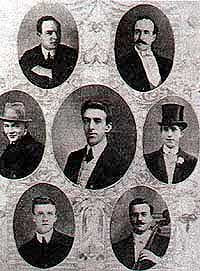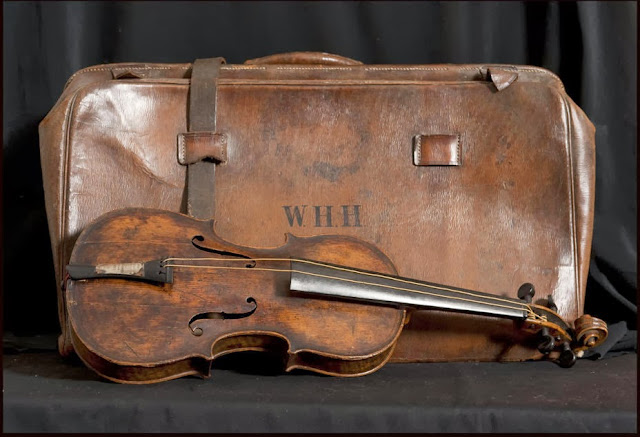After leaving school, Hartley started work with the Craven & Union Bank in Colne. When his family moved to Huddersfield, Hartley joined the Huddersfield Philharmonic Orchestra. In 1903, he left home to join the municipal orchestra in Bridlington, where he stayed for six years. He later moved to Dewsbury, West Yorkshire and in 1909, he joined the Cunard Line as a musician, serving on the ocean liners RMS Lucania, RMS Lusitania and RMS Mauretania.[2]
Whilst serving on the Mauretania, the employment of Cunard musicians was transferred to the music agency C.W. & F.N. Black, which supplied musicians for Cunard and the White Star Line. This transfer changed Hartley's onboard status, as he was no longer counted as a member of the crew, but rather as a passenger, albeit one accommodated in second-class accommodation at the agency's expense. It later transpired that neither the shipping company nor the music agency had insured the musicians, with each claiming it was the other's responsibility.[2]
In April 1912, Hartley was assigned to be the bandmaster for the White Star Line ship RMS Titanic.[2] He was at first hesitant to again leave his fiancée, Maria Robinson, to whom he had recently proposed, but Hartley decided that working on the maiden voyage of the Titanic would give him possible contacts for future work.
Apart from his short tenure as leader of the band on the Titanic, Hartley is also known for introducing the tritone substitution to ballroom dance music.[citation needed]
Sinking of the Titanic
After the Titanic hit an iceberg and began to sink, Hartley and his fellow band members started playing music to help keep the passengers calm as the crew loaded the lifeboats. Many of the survivors said that he and the band continued to play until the very end. None of the band members survived the sinking and the story of them playing to the end became a popular legend. One survivor who clambered aboard 'Collapsible A' claimed to have seen Hartley and his band standing on the boat deck, near the entrance to the grand staircase, near the base of the second funnel. He went on to say that he saw three of them washed off while the other five held on to the railing on top the Grand Staircase's deckhouse, only to be dragged down with the bow, just before Hartley exclaimed, "Gentlemen, I bid you farewell!" A newspaper at the time reported "the part played by the orchestra on board the Titanic in her last dreadful moments will rank among the noblest in the annals of heroism at sea."
After the sinking
Hartley's body was recovered by the Mackay–Bennett almost two weeks after the sinking, several press reports confirmed that Wallace was found "fully dressed with his music case strapped to his body".[3]
He was transferred to the Arabic and returned to England. Wallace's father Albion met the ship at Liverpool and brought his son back to his home town of Colne, Lancashire. The funeral took place on 18 May 1912. One thousand people attended his funeral, while an estimated 30,000 - 40,000 lined the route of his funeral procession.[2]
Hartley is buried in the Keighley Road cemetery, Colne, where a 10-foot headstone, containing a carved violin at its base, was erected in his honour.
A memorial to Hartley, topped by his bust, was erected in 1915 outside what was then the town library. This was later moved slightly to make way for the World War One memorial. Hartley's large Victorian terraced house in West Park Street, Dewsbury, West Yorkshire, bears a blue plaque to remind passers-by that this was the bandleader's home.[2]
As of 2001, Hartley's name was still being used when naming new streets and housing in the town of Colne. In 2008, the pub chain J D Wetherspoon named a newly opened pub, (the building having been the long-standing King's Head Hotel up until the mid-1990s),[4] in Colne after the bandleader.[5]
"I would be most grateful if you could convey my heartfelt thanks to all who have made possible the return of my late fiance's violin."[9]
After Maria Robinson's death in 1939, her sister gave the violin to the Bridlington Salvation Army and told its leader, a Major Renwick, about the instrument's association with the Titanic.[10] The violin was later passed on to a violin teacher who gave it to the current owner's mother. "It's been in the same family for over 70 years," Henry Aldridge and Sons state.[11] Craig Sopin, the owner of one of the world's largest collections of Titanic memorabilia, a leading Titanic expert, and a general skeptic of Titanic claims believes the violin is "Hartley's violin and not a fraud" reports ABC News.[12]
The Hartley violin has been on exhibition in the United States at Titanic Branson and Titanic Pigeon Forge, the largest Titanic museums in the World and is to be sold in England later in 2013.




No comments:
Post a Comment